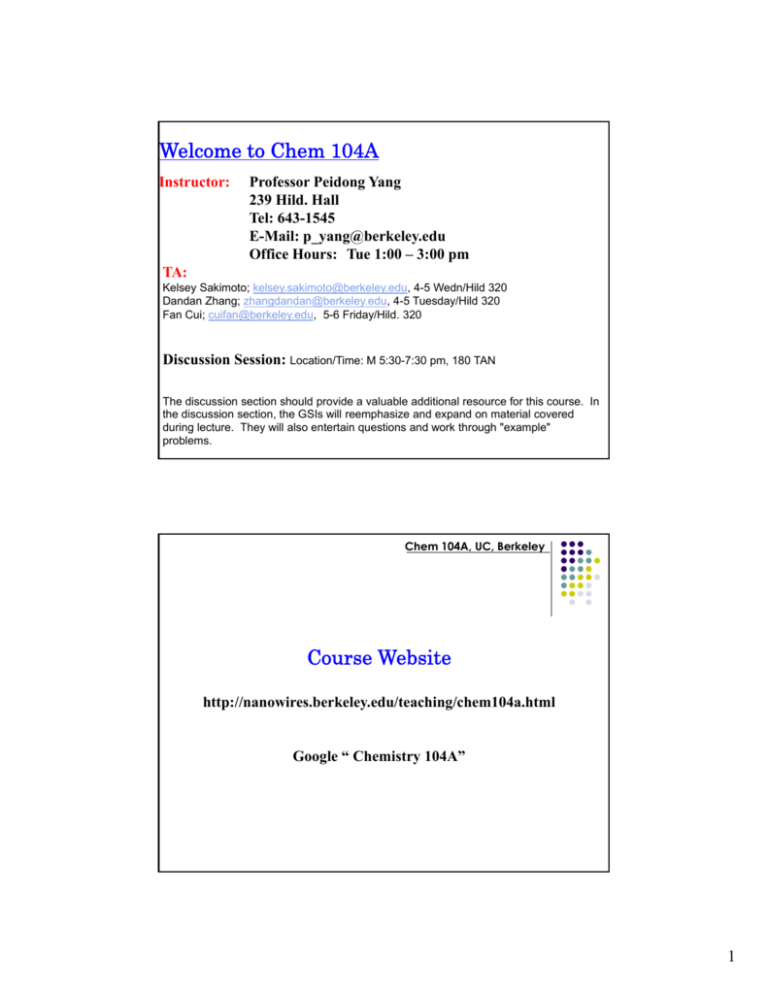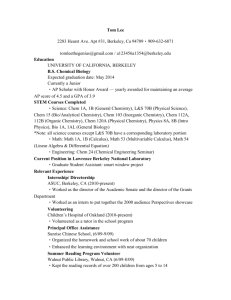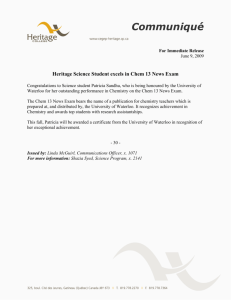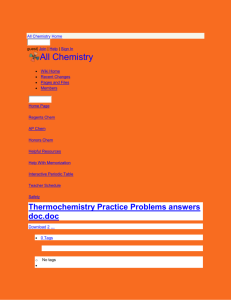Welcome to Chem 104A Course Website
advertisement

Welcome to Chem 104A Instructor: Chem 104A, UC, Berkeley Professor Peidong Yang 239 Hild. Hall Tel: 643-1545 E-Mail: p_yang@berkeley.edu Office Hours: Tue 1:00 – 3:00 pm TA: Kelsey Sakimoto; kelsey.sakimoto@berkeley.edu, 4-5 Wedn/Hild 320 Dandan Zhang; zhangdandan@berkeley.edu, 4-5 Tuesday/Hild 320 Fan Cui; cuifan@berkeley.edu, 5-6 Friday/Hild. 320 Discussion Session: Location/Time: M 5:30-7:30 pm, 180 TAN The discussion section should provide a valuable additional resource for this course. In the discussion section, the GSIs will reemphasize and expand on material covered during lecture. They will also entertain questions and work through "example" problems. Chem 104A, UC, Berkeley Course Website http://nanowires.berkeley.edu/teaching/chem104a.html Google “ Chemistry 104A” 1 Chem 104A, UC, Berkeley Chemistry 104A Inorganic Chemistry An introduction to inorganic chemistry Topics covered will include: Atomic structures, periodic trends, Symmetry and group theory, Molecular orbital theory, molecular structure, Inorganic solids & band theory Completion of a general chemistry sequence (chemistry 1B, 3A or 4B) is prerequisite. Chemistry 104A Inorganic Chemistry: Textbook Chem 104A, UC, Berkeley Miessler, G. L., Tarr, D. A. Inorganic Chemistry DeKock and Gray, Chemical Structure and Bonding, 2nd Ed., University Science Books, 1989 Optional (recommended) Vincent, Molecular Symmetry and Group Theory, Wiley, 2001. Important: The course material, and certainly what you will be responsible for on the exams, will be defined in lecture and based mainly on the class notes. Therefore, attendance in class is a key to success! The paperback book by Vincent is a valuable tool for learning about symmetry and group theory in chemistry. In addition, part of the course (in particular MO theory) will be based on material in the book by DeKock and Gray. 2 Chem 104A, UC, Berkeley Chem 104A, UC, Berkeley Chemistry 104A Inorganic Chemistry: Reference Books •Cotton, Wilkinson, and Gaus, Basic Inorganic Chemistry, Wiley, 1995 •Cotton, Chemical Applications of Group Theory, Wiley, 1990 •Douglas, McDaniel, and Alexander, Concepts and Models of Inorganic Chemistry, Wiley, 1994 •Huheey, Keiter, and Keiter, Inorganic Chemistry, 4th Ed. HaperCollins, 1993 •Shriver, Atkins, and Langford, Inorganic Chemistry, W. H. Freeman, 1990 •Porterfield, Inorganic Chemistry, Academic Press, 1993 •Cotton and Wilkinson, Advanced Inorganic Chemistry, 5th Ed., Wiley, 1998 •Greenwood and Earnshaw, Chemistry of the Elements, Butterworth Heineman, 1997 3 Chem 104A, UC, Berkeley Grading: Problem sets (6) Exam 1 (Oct. 2nd , in class) Exam 2 (Oct 30th, in class) Final (Dec 16th) 10% 25% 25% 40% Chem 104A, UC, Berkeley Final Grades Your grade for this class will be determined exclusively by the four criteria listed above (exams, problem sets, and final exam). Under no circumstances will alternative grading schemes be used to assign a final grade. Note that all grades are final, and not open to negotiation after they have been determined. Examinations Exams will cover material emphasized in the lectures, the required reading, and the problem sets. The midterms will be given in place of the regular lecture in class. No makeup exams will be given. Please mark these dates on your calendar immediately. If you have a legitimate reason (with documentation) to miss an exam, you may be excused from the exam and in this case your final grade will be based on your prorated other scores. If you know in advance of any reason that may cause you to miss any examination, you must see Prof. Yang immediately. Note: Dishonesty and cheating will not be tolerated. Evidence of cheating on an exam will result in a grade of zero for that exam, and further disciplinary action by the University. Regrade Policy The GSI's will hand back midterm exams after lecture periods and also in their office hours. Requests for regrades will only be considered if they are in the form of a written statement on a sheet of paper attached to the original, unaltered exam. No requests will be considered if they are handed in more than two weeks after the exam. 4 Chem 104A, UC, Berkeley Problem Sets You are strongly encouraged to work through the problem sets, as this will test your understanding of the course material, and exam questions may be similar to the material covered in the problem sets. Problem sets will be assigned during lecture, and the GSI's will collect your answers at the end of the lecture the following week. They will grade two of the problems in each set, chosen randomly, and your cumulative score on these problems will determine 10% of your final grade. Also, if you are on a grade border, regularly completed problem sets will be taken into account in determining whether or not your grade should be higher. Course Website http://nanowires.berkeley.edu/teaching/chem104a.html At this site, class notes and viewgraphs will also be posted. Please download the appropriate class notes and viewgraphs before coming to lecture. Chem 104A, UC, Berkeley What is inorganic chemistry? Organic Chemistry: the chemistry of life the chemistry of hydrocarbon compounds C, H, N, O Inorganic Chemistry: Non-living chemistry Chemistry of “everything else” Chemistry of the entire periodic table 5 Chem 104A, UC, Berkeley C N O Taxol Chem 104A, UC, Berkeley the drug that now has the generic name "paclitaxel", and the registered tradename "Taxol ®" (Bristol-Myers Squibb Company) The natural source, the Pacific yew tree, is an environmentally protected species, which is also one of the slowest growing trees in the world. Isolation of the compound, which is contained in the bark, involves killing the tree, and the quantities available by this method are pitifully small. It would take six 100-year old trees to provide enough taxol to treat just one patient. 6 Chem 104A, UC, Berkeley Constant “atomicity” (valence) Carbon: 4 bonds Hydrogen: 1 bond Nitrogen: 3 bonds Oxygen: 2 bonds August Kekule (1829-1896, German) Organic molecules: successful Inorganic molecules: ??? Chem 104A, UC, Berkeley Organic Compounds Inorganic Compounds Single Bond Double Bond Triple Bond Quadruple bond Coordination No. Constant Diverse Geometry Fixed Diverse 7 Chem 104A, UC, Berkeley Chem 104A, UC, Berkeley 8 Chem 104A, UC, Berkeley Chem 104A, UC, Berkeley Science 4 November 2005: Vol. 310. no. 5749, pp. 844 - 847 A Stable Compound with Fivefold Bonding Between Two Chromium(I) Centers 9 Chem 104A, UC, Berkeley Chem 104A, UC, Berkeley Total Synthesis of Taxol Need catalysts! The Importance of Inorganic Chemistry 10 Chem 104A, UC, Berkeley Oil Refining: Catalysts for converting crude oil to gasoline Chevron Richmond Refinery make transportation fuels, such as gasoline, jet fuel, and diesel fuel from crude oil capacity of 245,000 barrels of crude oil per day. Chem 104A, UC, Berkeley 11 Bioinorganic Chemistry Chem 104A, UC, Berkeley Chem 104A, UC, Berkeley Hemoglobin 12 Chem 104A, UC, Berkeley Photosynthesis Chem 104A, UC, Berkeley Semiconductor Industry 13 Chem 104A, UC, Berkeley Nanoscience & Nanotechnology Chem 104A, UC, Berkeley 14 Chem 104A, UC, Berkeley Buckyballs Harold Kroto from the University of Sussex, Robert Curl and Richard Smalley from Rice University—were awarded the Nobel Prize in Chemistry in 1996 for their discovery of a new composition of carbon, Carbon 60. Carbon-60 buckyball is shaped like a soccer ball. 18 Chem 104A, UC, Berkeley Carbon nanotube, 1991, NEC's Fundamental Research Laboratories 15 Chem 104A, UC, Berkeley Discovery of Graphene Andre Geim and Konstantin Novoselov Nobel prize in Physics, 2010 Chem 104A, UC, Berkeley Quantum Dots, Nanowires 16 Chem 104A, UC, Berkeley •Display technology •Energy storage Chem 104A, UC, Berkeley Common applications of inorganic chemistry •Catalysts: aluminum oxides, zeolites, transition metals •Semiconductors: Si, Ge, GaAs, InP •Polymers: silicones, (SiR2)n, polyphosphazenes •Superconductors: NbN, YBa2Cu3O7-x, Bi2Sr2CaCu2Oz •Magnetic Materials: Fe, SmCo5, Nd2Fe14B •Lubricants: graphite, MoS2 •Nanostructured materials: nanoclusters, nanowires and nanotube •Fertilizers: NH4NO3, (NH4)2SO4 •Paints: TiO2, PbCrO4 •Disinfectants/oxidants: Cl2, Br2, I2, MnO4•Water treatment: Ca(OH)2, Al2(SO4)3 •Industrial processes: H2SO4, NaOH, CO2 •Organic synthesis: reaction catalysts •Biology: Vitamin B12, hemoglobin, Fe-S protein 17 Chem 104A, UC, Berkeley What you will be able to do after taking this course? Predicting IR spectra, chemical analysis Chem 104A, UC, Berkeley Understand Molecular Orbitals Understand Chemical Reaction 18 Chem 104A, UC, Berkeley Hydrogen Car/Bus Chem 104A, UC, Berkeley A hydrogen bus system consists of non‐renewable H2 sources, hydrogen compressor, hydrogen tanks, and a bus propelled by electrical motors driven by a 60 kW hydrogen fuel cell stack and a 600V auxiliary battery. Current source of hydrogen: reforming methane, a fossil fuel or electrolysis using grid‐electricity 19 Chem 104A, UC, Berkeley Hydrogen Hydrogen has one of the highest energy density values per mass. Its energy density is between 120 and 142 MJ/kg Chem 104A, UC, Berkeley Common Crystal Structures and Electronic Structure 20 Chem 104A, UC, Berkeley Atomic Structure Reading: MT 1,2; DG 1 MT: Miessler, G. L., Tarr, D. A. Inorganic Chemistry, DG: DeKock and Gray, Chemical Structure and Bonding, 2nd Ed., University Science Books, Chem 104A, UC, Berkeley Rutherford Backscattering Thomson Model Rutherford Model 21 Chem 104A, UC, Berkeley 1913, Danish Physicist, Niels Bohr Electrostatic Fe = Outward Fo mv e r 2 e2 r2 Chem 104A, UC, Berkeley Total Energy: E mv e r 2 e2 r2 = KE + PE e2 1 2 E me v ( ) r 2 1 e2 e2 ( ) r 2 r e2 2r E <0 What would be lowest energy state? r0 22 Chem 104A, UC, Berkeley Come to the rescue…. Energy Quantized (Planck Equation) E = h Frequency Angular Momentum of electron is quantized. mev.r = nh/2 v nh 2me r h 6.62 10 34 J .s velocity Velocity of the electron quantized Chem 104A, UC, Berkeley m v2 e r v e2 2 r nh 2me r n2h2 n 2 a0 rn 2 2 4 me e o r1=Bohr radius =a0=0.529 A e2 1 me v 2 ( ) r 2 2 2 e 1 e ( ) r 2 r 2 e 2r E e2 2 2 me e 4 k En 2 2 2 2rn nh n k= 13.606 eV 23 Chem 104A, UC, Berkeley Chem 104A, UC, Berkeley 24 Chem 104A, UC, Berkeley Chem 104A, UC, Berkeley 1 1 ) n2 m2 wavenumber 1 / v RH ( RH 109679cm 1 Lyman Rydberg constant (n=1) v H 82259,97492,10824cm 1 25 Chem 104A, UC, Berkeley Chem 104A, UC, Berkeley Balmer Series (n=2) 26 Chem 104A, UC, Berkeley Bohr Model can NOT explain Zeeman effect. Chem 104A, UC, Berkeley Dual Nature of Matter Reading: MT 2, DG 1 1924, French physicist Louis de Broglie: All matter possesses wave properties h h mv p h 6.62 10 34 J .s 27 Chem 104A, UC, Berkeley Baseball: 200g Speed: 3000cm/sec (67 miles/hour) 10 32 cm Electron: 10 27 g Same velocity 20m Experimental evidence: electron diffraction Chem 104A, UC, Berkeley Interference between two point waves 28 Chem 104A, UC, Berkeley Chem 104A, UC, Berkeley The uncertainty principle 1927, Werner Heisenberg It is impossible to know simultaneously both the momentum and the position of a particle with certainty. h (p x )(x) 4 h 6.62 10 34 J s 29 Chem 104A, UC, Berkeley Accuracy: one part per trillion Baseball: 200g Speed: 3000 cm/sec (67 miles/hour) p 6 105 g cm sec 1 p 6 10 7 g cm sec 1 x 10 21 cm 27 Electron: 10 g Same velocity p 3 10 24 g cm sec 1 p 3 10 36 g cm sec 1 x 109 cm Chem 104A, UC, Berkeley Electron motion: wavefunction Describes spatial properties of electron. Must be: single valued, continuous, normalized Schrodinger wave equation (1926): 2 2 2 2 ( 2 2 2 ) V E 8 m x y z : wavefunction / eigenfunction h2 x, y, z : coordinates m : mass h : Planck ' s E : total energy V : potential energy H E H : Hamiltonian operator 30 Chem 104A, UC, Berkeley Converting to polar coordinates: n ,l ,m Rn ,l (r ) Yl ,m ( , ) l l Rn ,l (r ) Radial part Yl ,ml ( , ) Angular part Chem 104A, UC, Berkeley n=1,2,3,4….= principle quantum number (1): determine the energy of the electron (2): indicate approximately the effective volume of the orbital. e2 2 2 me e 4 k En 2rn n2h2 n2 n=1 2 3 31 Chem 104A, UC, Berkeley l = angular momentum (or shape) quantum number 0,1,2,3,4…… s, p, d, f….. Determine general shape of the orbital For each n, there are n possible angular momentum value Chem 104A, UC, Berkeley ml = magnetic/orbital orientation quantum number 0,1,2,3.... Determine orbital spatial orientation For each l, there are 2l+1 possible ml value. 32 Chem 104A, UC, Berkeley f orbitals 33








